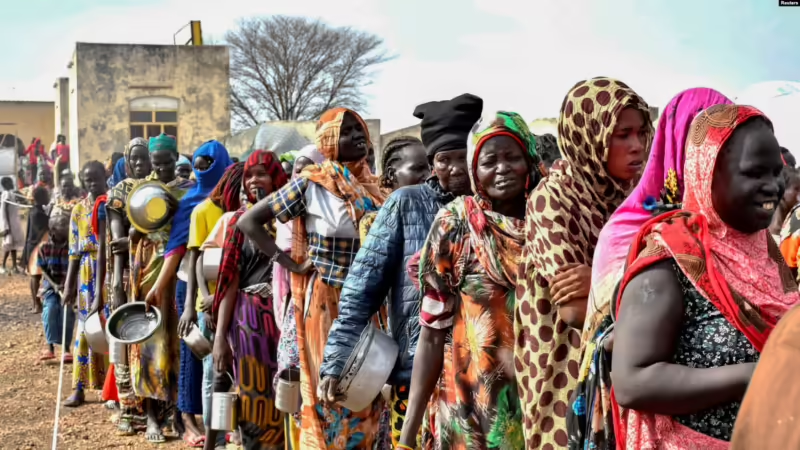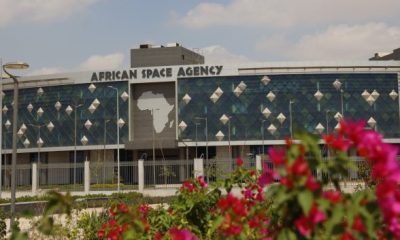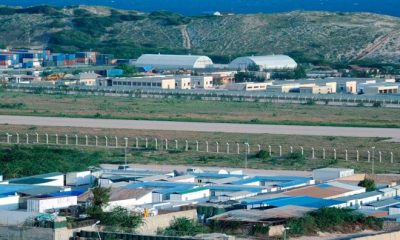Africa
The Oldest Known Image of the African Rail

Newly discovered rock art reveals a profound connection between the San people and the African rail, shedding light on the spiritual dimensions of ancient depictions.
In a remarkable discovery that bridges the ancient and the present, a newly identified rock painting may represent the oldest known image of the African rail (Rallus caerulescens), a bird native to sub-Saharan Africa. Found in a rock shelter in South Africa’s Western Cape, this ancient artwork could predate the well-known 1773 watercolour by Georg Foster, which has long served as the species’ holotype.

The African rail, with its striking blueish breast, reddish legs, and long toes, is a resident of the wetlands in South Africa’s Western Cape. It’s one of around 140 species within the Rallidae family, which includes coots, moorhens, and crakes. Foster’s watercolour, created during British explorer Captain James Cook’s expedition, has been a crucial reference for the species. However, this new find could significantly alter our understanding of the bird’s historical depiction.
Discovered by researchers from the African Centre for Coastal Palaeoscience at Nelson Mandela University, the painting measures 20cm in length and is part of a larger panel featuring other wildlife such as bees, aardvarks, and antelope. The rock art is believed to date back centuries, possibly even thousands of years, providing a window into the early interactions between humans and their environment.
The San people, who created this artwork, were not only exceptional trackers but also profound ornithologists. They are said to have had names for up to 68 out of 76 bird species observed in a single day. The San’s deep knowledge of birds is reflected in this painting, which captures the distinctive features of the African rail, including its characteristic barring.
However, this rock art reveals more than just an avian image. It suggests a spiritual dimension that might have imbued the bird with deeper significance. Many San rock artworks depict therianthropes—beings with both human and animal features. The African rail painting seems to blend bird-like and human characteristics, evident in the absence of the bird’s bill and the depiction of toes resembling human fingers. This could indicate that the artist intended to create a “rail-person,” merging human and avian forms into a symbolic representation.
The proximity of the rock shelter to the rail’s wetland habitat, combined with the bird’s memorable call and distinctive appearance, suggests that the San may have regarded the African rail as a conduit to the spirit world. This theory aligns with other San rock art interpretations, where birds like swifts or swallows are seen as intermediaries between the physical and spiritual realms.
Despite centuries of persecution and displacement, the San’s cultural and spiritual legacy remains profound. Their intricate knowledge of the natural world, now being rediscovered and valued, underscores their enduring contribution to our understanding of prehistoric human interactions with their environment. This ancient rock painting of the African rail not only enriches our knowledge of early human ornithology but also highlights the San’s complex spiritual and cultural worldview.
The discovery offers a poignant reminder of the rich tapestry of human history and the timeless connection between people and nature. It allows us to glimpse the world through the eyes of a people whose wisdom and artistry continue to inspire awe and respect.
Africa
IS-Linked ADF Rampage: 23 Killed, Dozens Kidnapped in Eastern DRC

The Islamic State (IS)-affiliated Allied Democratic Forces (ADF) have launched a series of brutal attacks, resulting in the deaths of at least 23 civilians and the abduction of dozens more, according to reports from the UN Office for the Coordination of Humanitarian Affairs (OCHA).
The attacks, which unfolded over two consecutive days in the Ituri Province, saw ADF militants ravaging several villages, leaving a trail of destruction and fear. Additional reports from the OCHA highlight further violence in the Beni Territory of North Kivu Province, where another 17 civilians were killed on Wednesday, underscoring the relentless brutality of the ADF’s campaign in the region.
The ADF, originally a Ugandan rebel group, has long been a source of instability in the eastern DRC, exploiting the dense forests to establish a base of operations from which they have conducted raids and kidnappings, often targeting remote villages with little to no defense.
In the wake of the attacks, hundreds of villagers fled to neighboring areas seeking safety from the violence that has torn through their communities. The situation remains dire, with local authorities and humanitarian organizations struggling to address the massive displacement and the ongoing security crisis.
The violence also spilled over into South Kivu Province, with local medical sources reporting deadly explosions at an M23 rally in Bukavu, which killed at least 11 people and injured dozens. This incident further complicates the already tense situation in the region, where more than 125,000 people have been displaced since early February due to continuous clashes.
Humanitarian efforts have been severely hampered by the ongoing conflict, with many organizations forced to temporarily suspend their operations. However, assessments have resumed, albeit under challenging and dangerous conditions.
The UN Refugee Agency (UNHCR) has reported a significant influx of Congolese civilians fleeing the conflict to Burundi, with an estimated 60,000 people seeking refuge in just two weeks. These refugees, including men, women, and children, have undertaken perilous journeys, walking hundreds of kilometers in a desperate search for safety.
UNHCR and its partners are ramping up assistance, setting up emergency shelters and distributing essential relief items such as food, water, sleeping materials, and hygiene kits to accommodate the growing number of displaced persons.
This ongoing crisis in the eastern DRC highlights the severe humanitarian consequences of armed conflict and the urgent need for increased international support to restore stability and provide relief to the thousands of civilians caught in the crossfire.
Africa
Algeria’s Selma Haddadi Rises: The New Power Broker in the AU

Algerian diplomat Selma Haddadi secures the AU Commission deputy chair, solidifying North Africa’s influence in the continental body.
Algeria has cemented its grip on African diplomacy as Selma Haddadi—the country’s ambassador to Ethiopia—secures the African Union Commission’s deputy chairmanship. Elected during the 38th AU Summit, Haddadi triumphed over five contenders from North Africa, reinforcing Algeria’s growing clout in continental affairs.
With a bold vision for Africa, Haddadi promises to infuse fresh energy into AU leadership, unlocking the continent’s human capital and advancing the African solutions to African problems agenda. Her victory signals a strategic shift, as Algeria strengthens its position in the AU alongside Djibouti’s Mahamoud Ali Youssouf, who clinched the chairperson seat.
This election reshapes AU leadership dynamics, with North and East Africa now wielding unprecedented influence. Haddadi’s challenge? Turning AU ambitions into reality—where bureaucratic inertia often stalls progress. With her diplomatic experience and Algeria’s backing, she could be the powerbroker Africa needs to push forward urgent reforms and assert continental autonomy.
Africa
African Nations Prepare for What’s to Come After Pause on US Aid

With Trump’s 90-day foreign aid freeze in place, African nations scramble for alternatives as vital health and infrastructure programs face uncertainty.
Trump’s aggressive freeze on US foreign aid has sent shockwaves through Africa, forcing governments to confront a grim reality—decades of reliance on American funding are crumbling. Health ministries, already stretched thin, are scrambling to find solutions as critical programs, including HIV/AIDS treatment under PEPFAR, teeter on the edge. Kenya, South Africa, and Nigeria—nations where millions depend on US-backed medical services—now face an existential crisis.
The blow isn’t limited to healthcare. In Senegal, a $550 million energy project designed to expand electricity access to 12 million people is now hanging by a thread. Without US dollars, infrastructure projects could grind to a halt, leaving economies in limbo. Leaders like Senegal’s Ousmane Sonko are calling for self-sufficiency, but with economies deeply tied to Western funding, the road ahead is uncertain.
The US claims life-saving aid will continue under limited waivers, but African officials aren’t convinced. The pause is a clear warning shot—Trump’s America is done footing the bill. Nigeria has already launched a task force to explore alternative financing, but can Africa truly stand on its own without Washington’s billions? The answer may come sooner than expected, as nations scramble to reshape their economic and political alliances in a world where US support is no longer guaranteed.
Africa
Senegal’s President Fights For Mandate in Parliamentary Race

Senegal’s political landscape is bracing for a pivotal parliamentary election on November 17, as President Bassirou Diomaye Faye pushes to consolidate power and advance his reform agenda. The election follows Faye’s decision to dissolve the opposition-led National Assembly, a move aimed at overcoming legislative resistance he claims has stalled his proposed anti-corruption measures and economic reforms. Campaigning, marked by fervent rallies and town-to-town caravans, has officially begun, setting the stage for a contest that may redefine the balance of power in Senegal.
Having secured the presidency with a resounding victory in April, Faye’s leadership faces a crucial test of public confidence. His Pastef party, which previously relied on coalitions, has decided to contest the election independently, aiming for a majority that would enable Faye to pass his proposed legislation unimpeded. Yet, the path to parliamentary dominance is far from assured. An unexpected coalition has emerged between former presidents Macky Sall and Abdoulaye Wade, bringing together two of Senegal’s most seasoned political actors. Their respective parties, the Alliance for the Republic (APR) and the Senegalese Democratic Party (PDS), dominated the outgoing assembly with 106 of the 165 seats, posing a formidable challenge to Pastef’s aspirations.
“This election has symbolic significance,” notes Mamadou Seck, a political analyst, who views it as a litmus test for Faye’s popularity following his electoral promises. “The critical challenge today is for Diomaye Faye to understand whether the people who elected him with 54% still support his program.” Seck observes that Pastef’s decision to run without a coalition might reflect a strategic gamble to gauge its standalone appeal, though the party has sought to strengthen its ranks by enlisting former allies of Sall.
A core component of Faye’s pitch to voters is an ambitious 25-year development plan unveiled earlier this month. This blueprint outlines bold goals to stimulate local industries, diversify Senegal’s economy, and generate job opportunities amid a fast-growing population. These objectives resonate with Faye’s anti-corruption and development rhetoric, which have been central to his political message. If Pastef secures a parliamentary majority, the plan could proceed with fewer legislative barriers, potentially shaping Senegal’s economic trajectory for decades.
Beyond Pastef and the Sall-Wade coalition, the election also features opposition figures such as former Prime Minister Amadou Ba and Dakar’s Mayor Barthelemy Dias, who head smaller opposition alliances. Dias, a vocal critic of the current administration, has cultivated a base in Dakar, an urban stronghold critical to influencing the capital’s vote. Their involvement underscores the stakes of the parliamentary contest and highlights the diverse opposition Faye faces as he seeks to establish his administration’s legislative foundation.
As the election draws near, Faye has called for a “peaceful and dignified” campaign, emphasizing a commitment to ensuring a transparent and respectful democratic process. “I wish all Senegalese and all political actors a peaceful and dignified electoral campaign, and I guarantee that… the best will win,” Faye said in a televised address. This message of unity aims to temper the charged atmosphere surrounding the race, especially as past elections in Senegal have occasionally sparked unrest amid high political fervor.
Should Faye succeed in securing a majority, he will gain a crucial mandate to advance his agenda, allowing for potentially transformative policies. However, a strong showing by the Sall-Wade coalition could spell renewed legislative resistance, challenging Faye’s leadership and testing his ability to navigate Senegal’s complex political landscape. For Senegalese voters, this election will shape not only the immediate future but also the long-term economic and social priorities of one of West Africa’s most stable democracies.
Africa
War Affects More Than 600 Million Women and Girls, UN Says

War now affects over 600 million women and girls worldwide, a staggering 50% increase in just a decade, according to a recent United Nations report. As conflicts intensify and political landscapes shift, U.N. leaders warn that the decades of progress toward gender equality and women’s rights are increasingly at risk. U.N. Secretary-General António Guterres highlighted in a new report the troubling erosion of rights and opportunities for women, saying, “generational gains in women’s rights hang in the balance around the world.”
The findings coincide with the anniversary of U.N. Security Council Resolution 1325, a landmark decision adopted on October 31, 2000, that advocated for equal participation of women in peacebuilding and conflict resolution. More than 20 years on, women’s involvement in peace negotiations remains negligible, hampered by persistent patriarchal structures and limited decision-making power for women in peace and security matters. Guterres emphasized the enduring imbalance: “As long as oppressive patriarchal social structures and gender biases hold back half our societies, peace will remain elusive.”
The report presented a bleak outlook for women in conflict zones, where the rate of female casualties has doubled in the past year. U.N.-verified incidents of conflict-related sexual violence have surged by 50%, and the number of girls affected by violence has risen by 35%. This alarming trend is evident across various regions: from Afghan girls barred from education to Sudanese women enduring sexual violence, and displaced women in Gaza, Syria, and Yemen grappling with the grim realities of conflict.
Sima Bahous, head of U.N. Women, highlighted the pervasive sense of abandonment felt by the 612 million women and girls affected by war, stating that they “wonder if the world has already forgotten them.” Bahous also highlighted stark statistics on food insecurity and health, revealing that one in two women in conflict zones face moderate to severe hunger, and that 61% of global maternal deaths occur in 35 conflict-ridden countries.
Despite the overwhelming need, progress toward including women in peacebuilding remains stalled. Bahous cited the discouraging statistic that women’s representation in peace negotiations has averaged below 10% over the past decade, reaching only 20% in U.N.-supported processes. The U.N. recently introduced a “Common Pledge on Women’s Participation in Peace Processes,” spearheaded by Deputy Secretary-General Amina Mohammed, aimed at urging governments and organizations to appoint more women as lead mediators and to consult with female leaders at all stages of peace processes.
In response to the U.N. findings, diplomats expressed frustration at the ongoing lack of political commitment to advancing women’s roles in peace efforts. Panama’s U.N. Ambassador Eloy Alfaro de Alba spoke directly to this issue, citing the continued absence of “political will” as a key obstacle in fulfilling member states’ commitments to gender equality in conflict resolution.
With calls for concrete action growing louder, the U.N. is emphasizing the need for meaningful inclusion of women in peace processes—not only as a matter of equality but as an essential step toward achieving sustainable peace.
Africa
WHO Urges Rwanda to see off Marburg Outbreak

The World Health Organization (WHO) has commended Rwanda’s robust response to the ongoing Marburg virus outbreak, which has so far resulted in 62 confirmed cases and 15 deaths. Speaking in the Rwandan capital, Kigali, WHO Director-General Tedros Adhanom Ghebreyesus emphasized the importance of sustained vigilance, even as the number of new cases has slowed. Rwanda has recorded no new infections in the past six days, with 44 people recovering from the virus.
“We are encouraged by the fact that no new cases have emerged in recent days, but we must remember that we are dealing with one of the world’s deadliest viruses,” Tedros said during a press conference. “Enhanced surveillance, contact tracing, and infection control measures must continue at full scale until the outbreak is declared officially over.”
Marburg virus, a highly infectious pathogen similar to Ebola, has a fatality rate of up to 88%. The virus causes hemorrhagic fever, with symptoms including severe bleeding and organ failure. However, the mortality rate in the current Rwandan outbreak has been notably lower, at 24%, largely due to the country’s swift and effective response.
Tedros visited a treatment center over the weekend, where he praised the medical staff for saving the lives of two critically ill patients who had suffered multiple organ failure. “These patients were successfully intubated, placed on life support, and have since been extubated and are now recovering,” he noted. This marks the first time patients with Marburg virus have been successfully extubated in Africa, a significant milestone in the treatment of the disease.
While there are no approved vaccines or antiviral treatments for Marburg, potential therapies, including blood products and immune treatments, are currently being evaluated. Earlier this month, Rwanda also initiated a vaccination trial in a bid to curb the outbreak.
Tedros cautioned that an official declaration that the outbreak is over can only be made after 42 days—equivalent to two incubation periods—without any new confirmed cases. He reiterated that continued vigilance is critical, stressing that the nature of the virus leaves no room for complacency.
The Marburg virus is transmitted to humans via fruit bats and can spread between humans through direct contact with bodily fluids or contaminated surfaces. With Rwanda making strides in containing the outbreak, the country’s efforts are being closely watched as a potential model for managing future outbreaks of similar diseases.
Africa
African Port Growth Hindered by Poor Road, Rail Networks, Report Says

Africa’s port infrastructure has experienced significant growth, spurred by an estimated $15 billion in investments since 2005. These investments have allowed African ports to accommodate larger vessels and increase cargo throughput, with container traffic rising by nearly 50% from 2011 to 2021, according to the African Development Bank. Yet, despite these advancements, the continent’s inland logistics remain a significant hurdle to efficient supply chain operations, as highlighted by the Africa Finance Corporation’s 2024 “State of Africa’s Infrastructure” report.
Gabriel Sounouvou, a logistics and supply chain specialist, notes that while modernizing ports has led to improvements such as greater integration into the global supply chain and reduced corruption, these gains have not translated into more efficient movement of goods within Africa. The primary bottleneck lies in underdeveloped road and rail networks, which, despite port expansions, remain inadequate, unevenly distributed, and underutilized.
The poor quality of road networks is especially problematic. Sounouvou explains that many trucks are forced to navigate poor road corridors, causing severe delays. Goods transported from ports to landlocked countries often take more than 10 days to arrive instead of the three days that could be expected under better conditions. This logistical challenge is exacerbated in areas far from coastal ports, where the cost of doing business soars due to infrastructure deficits.
In addition to infrastructure, human factors also present significant challenges. Jonas Aryee, a maritime trade expert, points out that regulatory roadblocks such as customs checks, police stops, and border delays contribute to the high costs and inefficiency of transporting goods across African countries. These barriers, along with protectionist policies that safeguard domestic industries at the expense of regional trade cooperation, further stymie the development of a seamless continental logistics network.
According to the AFC study, Africa’s paved road network totals just 680,000 kilometers, a mere 10% of the road infrastructure found in India, despite Africa’s larger land area and comparable population size. This stark gap illustrates the lack of coordinated investment and infrastructure development across the continent. Experts argue that without a concerted effort from African nations to jointly invest in and manage cross-border highway networks, the potential benefits of port modernization will remain unfulfilled.
While inland infrastructure remains a critical issue, the momentum for port investment continues. Several new terminal projects are slated for development in countries such as Angola, Benin, Cameroon, Ghana, the Democratic Republic of Congo, and Ivory Coast. However, for these investments to translate into broader economic gains, African nations must address the chronic underdevelopment of road and rail systems that are vital for efficient logistics and trade integration.
Ultimately, the development of a more robust and interconnected transportation network—integrating ports, roads, and railways—is crucial for unlocking the full economic potential of Africa’s growing port infrastructure. Without it, Africa risks missing out on the opportunity to fully participate in the global supply chain, with inefficiencies continuing to hamper economic growth and regional trade.
Africa
Oil Production Rises as Nigeria Intensifies Clampdown on Theft

Nigeria’s intensifying crackdown on crude oil theft is yielding notable progress, as the country aims to curb the massive financial losses caused by illicit activities in its oil-producing regions. The concerted efforts, driven by Operation Delta Safe, have reportedly led to a 16.7% increase in oil output over the past year, marking a significant step forward in securing the nation’s key resource.
Security forces under the joint land and air command of officers like Jamal Abdussalam and Ali Idris have shut down illegal refineries, recovered millions of liters of stolen crude, and made numerous arrests. Abdussalam underscored the impact of military presence in deterring oil thieves, noting, “Once they see soldiers, they take to their hills.” He emphasized that security operations are not just focused on arrests but also on dismantling and destroying the infrastructure used for illegal refining.
The cooperation between Nigerian authorities and international oil companies (IOCs) has been crucial to the success of this campaign. Idris highlighted that the IOCs have been instrumental in providing intelligence on illegal pipeline connections, significantly improving the military’s ability to combat theft. This collaboration has helped Nigeria address a long-standing issue that has plagued its oil industry for years.
Technological advancements have also played a central role in Nigeria’s efforts. According to Chief of Defense Staff Christopher Musa, the use of drones, maritime surveillance systems, and helicopters has enhanced the monitoring and protection of oil pipelines across the difficult and swampy terrain of the Niger Delta. These tools, alongside traditional patrols, have allowed the security forces to target and dismantle illegal refineries more effectively.
The stakes are high for Nigeria, as oil theft continues to drain the nation’s economy. Estimates from the Senate suggest that in 2022, Nigeria lost $23 million daily due to theft, and a staggering $1.43 billion was lost in March 2023 alone. Operation Delta Safe is seen as a critical response to this crisis, with a production goal of 1.7 million barrels per day this year—a target that officials are optimistic can be met.
However, challenges remain. Emeka Onumajuru, Delta Safe’s defense training and operations chief, acknowledged that while progress has been made in securing pipelines and reducing theft, the region’s rough terrain and lack of effective community engagement continue to pose significant hurdles. The Niger Delta, characterized by its dense forests and difficult swampy environment, makes it difficult for security forces to operate efficiently. Moreover, weak relationships between oil companies and local communities contribute to tensions, increasing the risk of sabotage and theft.
Musa emphasized the importance of fostering strong ties with local communities, recognizing that their cooperation is essential for long-term success. “We’re going to work with them to ensure that whatever is due for them, they get,” he stated, underscoring the government’s commitment to ensuring equitable distribution of oil revenues. This approach, officials hope, will reduce the likelihood of community grievances that often fuel illegal activities.
While Operation Delta Safe is being hailed as a major achievement in Nigeria’s ongoing battle against oil theft, experts caution that sustaining these gains will require continued collaboration among security forces, government agencies, and local stakeholders. Without an enduring framework for cooperation and engagement, the illicit trade that has undermined Nigeria’s oil industry for decades could resurface, potentially eroding the progress made thus far.
The future of Nigeria’s oil production, and indeed the stability of the region, hinges on this delicate balance of military enforcement, technological advancements, and meaningful community engagement.
-

 Analysis1 month ago
Analysis1 month agoSaudi Arabia’s Billion-Dollar Bid for Eritrea’s Assab Port
-

 ASSESSMENTS3 weeks ago
ASSESSMENTS3 weeks agoOperation Geel Exposes the Truth: International Community’s Reluctance to Embrace Somaliland as a Strategic Ally
-

 Somaliland3 months ago
Somaliland3 months agoSomaliland and UAE Elevate Ties to Comprehensive Strategic Partnership
-

 Africa1 year ago
Africa1 year agoHow Somaliland Could Lead the Global Camel Milk Industry
-

 Analysis1 year ago
Analysis1 year agoIran escalates conflict, attacking Israel; US forces help Israel to intercept Iranian projectiles
-

 Top stories11 months ago
Top stories11 months agoGunmen Kill 11 in Southeastern Nigeria Attack, Army Reports
-

 Analysis1 year ago
Analysis1 year agoIsrael and Iran on Edge: Tensions Escalate Amidst Rising Threats
-

 TECH11 months ago
TECH11 months agoZimbabwe Approves Licensing of Musk’s Starlink Internet Service




























